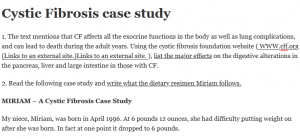Cystic Fibrosis case study

1. The text mentions that CF affects all the exocrine functions in the body as well as lung complications, and can lead to death during the adult years. Using the cystic fibrosis foundation website ( WWW.cff.org (Links to an external site.)Links to an external site. ), list the major effects on the digestive alterations in the pancreas, liver and large intestine in those with CF.
2. Read the following case study and write what the dietary regimen Miriam follows.
MIRIAM – A Cystic Fibrosis Case Study
My niece, Miriam, was born in April 1996. At 6 pounds 12 ounces, she had difficulty putting weight on after she was born. In fact at one point it dropped to 6 pounds.
After a spell in hospital in December 1996, when she was suffering from bronchitis, it was thought that she had asthma but my sister-in-law was already beginning to suspect that Miriam had Cystic Fibrosis. There was no other explanation of the symptoms which Miriam had.
Eventually, Miriam was given a “sweat test” and it was confirmed that she had Cystic Fibrosis. Both Tim & Sue are carriers – which is how they unknowingly passed on the faulty CF gene to Miriam.
No sooner had Miriam’s CF been diagnosed, shortly before she was one year old, than the medical support swung into action. The family had meetings with all members of the CF team – a doctor, a nurse, a social worker, a physiotherapist and a dietitian.
Miriam is now approaching five years old. Before she goes to school in the morning, she has around 30 minutes of inhalers and physiotherapy. With every meal she has to eat a number of “Creons”, mixed in with her food, which help her to digest her food. She has to eat a high fat and high calorie diet.
In the evening, she has another 40 minutes of inhalers, physiotherapy and nebulizers. She then has to take a variety of antibiotics, fluoride and vitamins.
Not surprisingly, all these medications have side effects – Miriam can be fairly hyperactive, she is always hot, and it takes her a long time to get to sleep each night.
Every nine weeks, Miriam is taken to the CF clinic. When Miriam has a particularly bad infection, it is necessary for her to go into hospital to receive a course of intra-venous antibiotics. The threat of infection is an ever-constant danger. To counter the risk of cross-infection, there are individual cubicles in the CF clinic and strict hygiene standards apply. Miriam cannot play or mix with other children with CF.
Inevitably all this has a major impact on the family. Every time they go on holiday – however short – all the drugs and equipment need to be taken with them. If they go out for the day, or when they are on holiday, Miriam’s daily routine of physio each morning and evening have to be fitted in – meaning no early starts, and no stopping out late.
(adapted from http://people.exeter.ac.uk/ajohnson/miriam.htm) (Links to an external site.)Links to an external site. (Links to an external site.)Links to an external site.
3. Using the information from Chapter 13 and the formula provided below, complete the question a-c.
Table: DRIs for Energy for Children (Available at: http://books.nap.edu/openbook.php?record_id=10490&page=107 (Links to an external site.)Links to an external site. )
EER for Girls 9 Through 18 Years
EER = 135.3 – (30.8 ´ age [y]) + PA ´ (10.0 ´ weight [kg] + 934 ´ height [m]) + 25 kcal
PA = 1.00 if PAL is estimated to be ≥ 1.0 < 1.4 (sedentary)*
PA = 1.13 if PAL is estimated to be ≥ 1.4 < 1.6 (low active)
PA = 1.26 if PAL is estimated to be ≥ 1.6 < 1.9 (active)
PA = 1.42 if PAL is estimated to be ≥ 1.9 < 2.5 (very active)
a. Calculate the estimated nutritional requirements for a 10-year-old female with cystic fibrosis who weighs 62 pounds and is 51 inches tall and is considered low active.
b. The estimated calorie requirement for an individual with cystic fibrosis is two to four times the usual recommendation. How would one know the appropriate calorie level to recommend initially?
c. Research the nutrition recommendations for cystic fibrosis ( https://www.cff.org/Living-with-CF/Treatments-and-Therapies/Nutrition (Links to an external site.)Links to an external site. or https://medlineplus.gov/ency/article/002437.htm (Links to an external site.)Links to an external site. ) that can assist an individual with meeting her high calorie and protein requirements. What advice could you provide to a patient?
4. What have you learned about treatment for CF?
5. (Optional, one extra credit point) Read the paper, “ Caregiver Coping, Mental Health and Child Problem Behaviors in Cystic Fibrosis: A Cross-Sectional Study,” Jane Sheehan, Int.J. Behav. Med. (2014) 21:211–220. The thesis of the paper is that the caregiver coping strategies is related to the health of the CF child.
a. Complete the table below defining the characteristics noted in the paper of a proactive or adaptive coping strategy and an avoidant or passive coping strategy.
| CF behavior issues | Proactive/Adaptive | Avoidant/Passive |
b. What are the overarching outcomes of the two coping strategies in the health of the child?